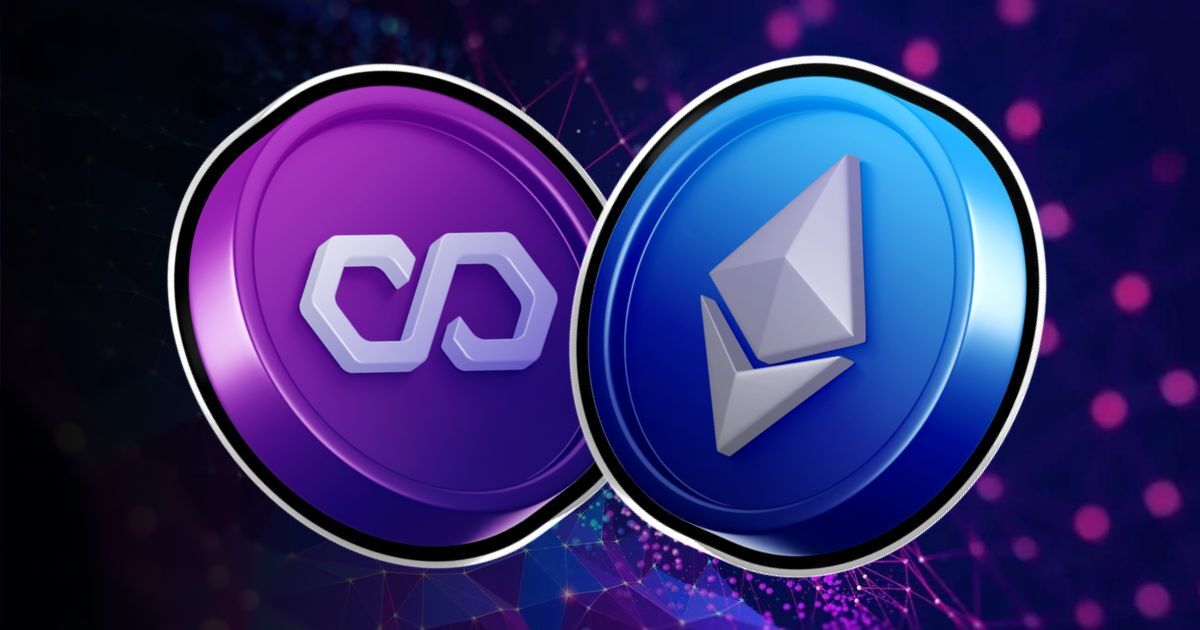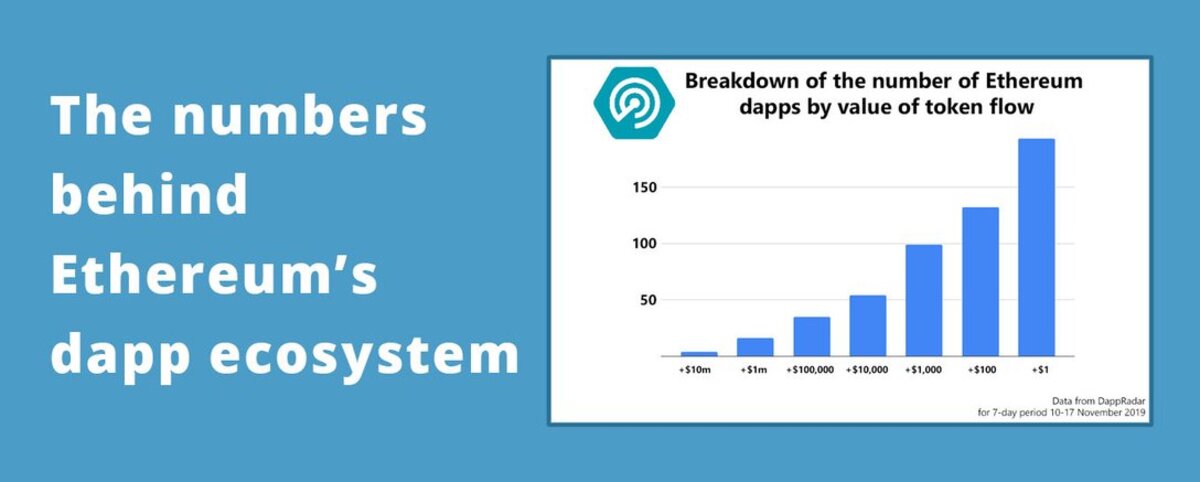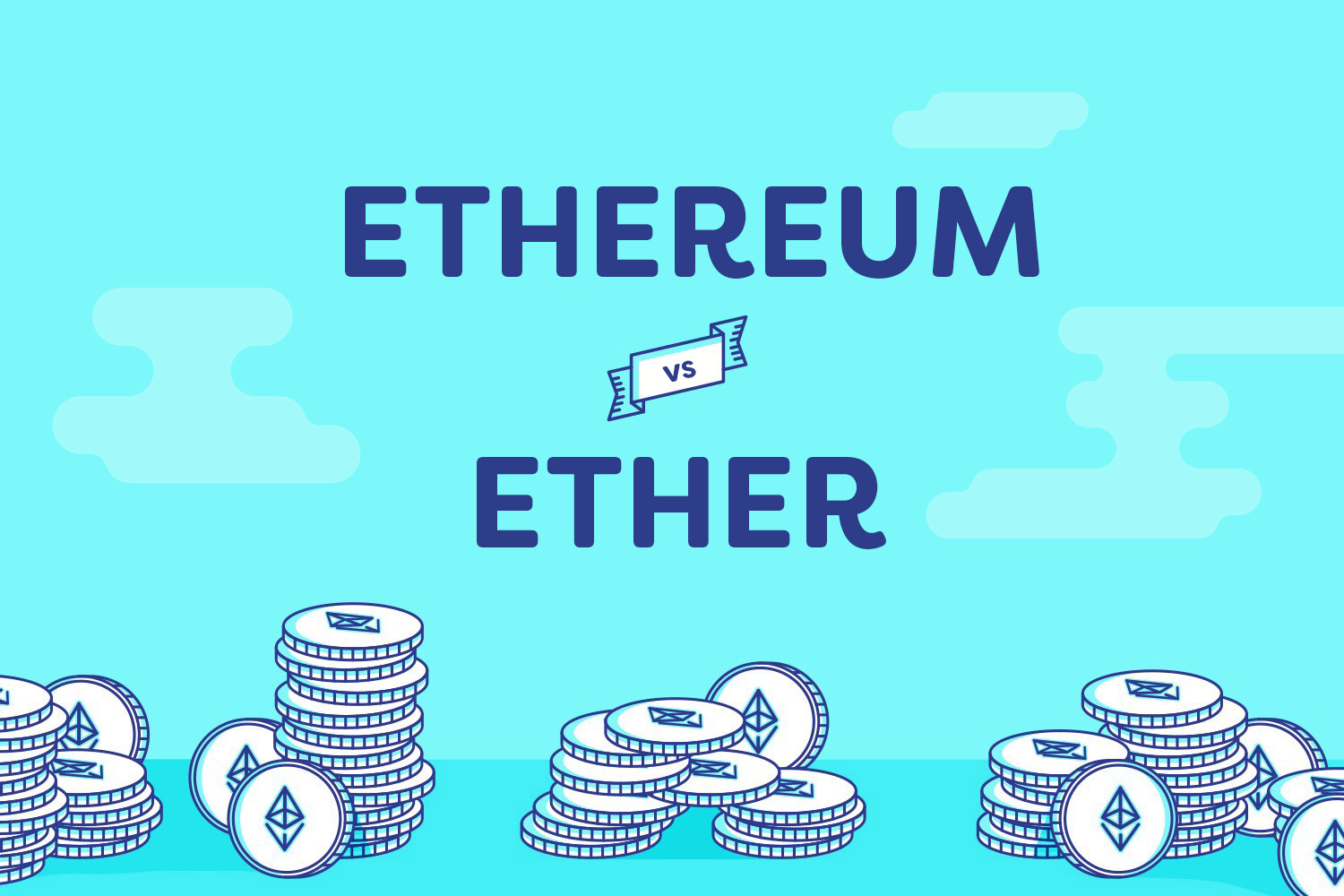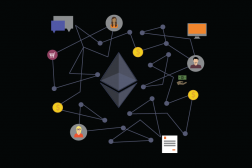Introduction
Welcome to the world of decentralized applications, or Dapps for short. In this era of digital transformation, Dapps are gaining immense popularity for their ability to provide secure, transparent, and trustless solutions using blockchain technology. Among the various blockchain platforms available, Ethereum stands out as a powerful and versatile platform for building Dapps.
In this article, we will explore the process of building a Dapp on the Ethereum blockchain. Whether you are a seasoned developer looking to expand your skillset or a newcomer with a curiosity for blockchain development, this guide will provide you with a comprehensive overview of the essential concepts, tools, and techniques involved in creating your own Dapp.
So, what exactly is a Dapp? A decentralized application is an application that runs on a distributed network of computers rather than on a centralized server. This enables Dapps to operate independently, without the need for intermediaries or trust in a single entity.
Ethereum, often referred to as the “world computer,” offers a robust infrastructure for developing and deploying smart contracts, which are self-executing contracts with the terms of the agreement directly written into code. These smart contracts power the logic and functionality of Dapps on the Ethereum network.
Building a Dapp on Ethereum opens up a world of possibilities. You can create decentralized finance (DeFi) applications like decentralized exchanges, lending platforms, or prediction markets. You can also develop supply chain solutions, digital identity systems, gaming platforms, and more. The potential for innovation and disruption is vast, as Ethereum provides a flexible and programmable platform for developers to unleash their creativity.
Before we dive into the technical aspects, it’s essential to have a clear understanding of the Ethereum blockchain and the role of smart contracts. In the following sections, we will walk you through the process of setting up your development environment, writing smart contracts in Solidity, designing the user interface, interacting with the Ethereum network, testing and debugging your Dapp, securing your application, and finally deploying it on the Ethereum network.
Whether you aim to create your own Dapp or gain a deeper understanding of the technology that underpins the blockchain revolution, this guide will equip you with the knowledge and skills you need to get started.
What is a Dapp?
A decentralized application, or Dapp, is an application that operates on a decentralized network, typically a blockchain. Unlike traditional applications that rely on a single central authority, such as a company or government, Dapps are built on distributed systems that operate without a central entity controlling the application.
One of the key attributes of a Dapp is decentralization, which means that no single entity has full control over the application or its data. Instead, the application operates using consensus algorithms and peer-to-peer networks to ensure that decisions are made collectively and transparently.
In addition to decentralization, Dapps are designed to be open-source, meaning that the source code is available for anyone to view, modify, and contribute to. This promotes transparency and collaboration within the development community.
Another important aspect of Dapps is their use of smart contracts. Smart contracts are self-executing contracts with the terms of the agreement directly written into code. They automatically execute actions when certain conditions are met, eliminating the need for intermediaries or trusted third parties.
Dapps can be used across various industries and applications. They have the potential to disrupt and innovate sectors such as finance, supply chain management, healthcare, gaming, and more. For example, in the finance industry, Dapps can enable the creation of decentralized lending platforms, decentralized exchanges, and automated investment systems.
One of the main advantages of Dapps is their security. Traditional centralized applications are vulnerable to hacks and data breaches due to their reliance on centralized servers. Dapps, on the other hand, use cryptography and consensus algorithms to ensure the integrity and security of the application and its data.
Furthermore, Dapps provide a level of transparency that is often lacking in centralized applications. Since all transactions and data are recorded on a public blockchain, anyone can audit and verify the information. This eliminates the need for trust in a single authority and promotes transparency and accountability.
In summary, a Dapp is a decentralized application that operates on a distributed network like a blockchain. It is characterized by its decentralization, open-source nature, use of smart contracts, and potential for disruption in various industries. With their enhanced security, transparency, and trustless nature, Dapps offer a new paradigm for building applications that are reliable, transparent, and resistant to censorship.
Why Build a Dapp on Ethereum?
When it comes to building decentralized applications (Dapps), Ethereum remains the platform of choice for many developers. Here are several reasons why building a Dapp on Ethereum can be a smart decision:
1. Established and Active Community: Ethereum has one of the largest and most vibrant communities in the blockchain space. This means that you’ll have access to a wealth of resources, documentation, tutorials, and developer tools. Additionally, being part of the Ethereum community allows you to collaborate with other developers, share knowledge, and learn from experienced individuals.
2. Powerful and Versatile: Ethereum provides a powerful and programmable platform for building Dapps. It supports Turing-complete smart contracts, which means that you can create complex and sophisticated logic within your applications. With Ethereum, you have the flexibility to design and develop Dapps that suit your specific requirements.
3. Interoperability and Ecosystem: Ethereum has a robust ecosystem of projects, libraries, and tools that can be leveraged to enhance your Dapp. The Ethereum Virtual Machine (EVM) allows for interoperability between different Dapps and smart contracts, enabling seamless integration with existing projects. This increases the potential for collaboration, interoperability, and adoption of your Dapp.
4. Security and Reliability: Ethereum has a proven track record for security and reliability. Its consensus mechanism, known as Proof of Work (PoW), ensures that transactions are validated and confirmed by the network. Additionally, Ethereum’s history and extensive use have led to rigorous testing and auditing of its core protocols, making it a trusted platform for building secure and reliable Dapps.
5. Tokenization and Decentralized Finance (DeFi): Ethereum pioneered the concept of tokenization, allowing the creation and management of digital assets on the blockchain. This has enabled the explosive growth of decentralized finance (DeFi) applications, including lending platforms, decentralized exchanges, and stablecoins. By building your Dapp on Ethereum, you can tap into the exciting landscape of DeFi, providing users with unprecedented financial opportunities.
6. Scalability and Upcoming Upgrades: While scalability has been a challenge for Ethereum in the past, there are ongoing upgrades to address this issue. Ethereum 2.0, also known as Eth2 or Serenity, will introduce a new consensus mechanism called Proof of Stake (PoS) and improve scalability through the implementation of shard chains. These upgrades will enhance the network’s capacity and performance, making it even more attractive for building scalable Dapps.
7. Future-Proof and Continuous Development: Ethereum has a clear roadmap for its development and improvement. The Ethereum Foundation and its community are committed to addressing challenges, improving scalability, and exploring innovative solutions. By building on Ethereum, you can be confident that your Dapp will benefit from ongoing advancements and upgrades, ensuring its relevance and longevity in the rapidly evolving blockchain landscape.
In summary, Ethereum offers a combination of an established community, a powerful platform, extensive interoperability, security, and a vibrant ecosystem. These factors make it an ideal choice for building Dapps. By leveraging the capabilities of Ethereum, you can create innovative, secure, and interoperable applications that tap into the vast potential of blockchain technology.
Getting Started
If you’re ready to embark on the journey of building a Dapp on Ethereum, here are some essential steps to get you started:
1. Understand Blockchain Basics: Before diving into Ethereum development, it’s crucial to have a solid understanding of blockchain technology. Familiarize yourself with concepts such as decentralized networks, consensus mechanisms, transactions, blocks, and the importance of immutability and cryptography.
2. Learn Solidity: Solidity is the programming language used to write smart contracts on the Ethereum platform. Familiarize yourself with the syntax, data types, control structures, and functions in Solidity. There are various online resources, tutorials, and courses available to help you learn Solidity.
3. Set Up Your Development Environment: To start developing on Ethereum, you’ll need to set up your development environment. Install the Ethereum client software, such as Geth or Parity, and set up your local Ethereum node. Additionally, you’ll need an Integrated Development Environment (IDE) with Solidity support, such as Remix or Visual Studio Code with the Solidity extension.
4. Get Test Ether: In the Ethereum development environment, you’ll need Ether to deploy and interact with your Dapp. However, you don’t need to use real Ether. You can obtain test Ether from faucet services specifically designed for testing purposes, such as the Rinkeby or Ropsten test networks.
5. Use Ethereum Development Tools: Ethereum offers various development tools and frameworks that can accelerate the development process. Tools like Truffle and Hardhat assist with project setup, compiling contracts, running tests, and deploying Dapps to Ethereum networks. Web3.js and ethers.js are popular libraries for interacting with smart contracts and the Ethereum network.
6. Join Developer Communities: Engage with the Ethereum developer community to learn, collaborate, and seek support. Participate in online forums, developer meetups, and social media channels like Ethereum Stack Exchange, Reddit, Discord, and GitHub. The Ethereum community is known for its knowledge sharing and helpfulness, so don’t hesitate to ask questions and contribute to discussions.
7. Start Building Simple Smart Contracts: Begin by developing simple smart contracts to understand the basics. Create smart contracts for common use cases like token creation, crowdfunding, or simple games. Deploy these contracts to a test network, interact with them, and explore various features and functionalities of the Ethereum platform.
8. Explore Dapp Development Frameworks: Dapp development frameworks like Truffle and Embark provide additional tools and libraries to simplify the development process. These frameworks offer features like automated contract testing, deployment scripts, and frontend integration, enabling you to focus on the core logic of your Dapp.
9. Learn Web Development Technologies: To build the user interface for your Dapp, you’ll need expertise in web development technologies such as HTML, CSS, and JavaScript. Familiarize yourself with frontend frameworks like React, Angular, or Vue.js. These frameworks allow you to create dynamic and interactive interfaces for your Dapp.
10. Continuously Learn and Iterate: Blockchain technology and Ethereum are evolving rapidly. Stay updated with the latest advancements, improvements, and best practices. Explore new tools, libraries, and languages that may enhance your development workflow. Be open to feedback and continuously iterate on your Dapp to improve its functionality and user experience.
Now that you have a roadmap to guide you, it’s time to roll up your sleeves and start building your Dapp on Ethereum. Remember, learning and development are ongoing processes, so embrace challenges and enjoy the journey of creating decentralized applications that can revolutionize industries and empower users.
Setting Up the Development Environment
Before you can start developing a Dapp on Ethereum, it’s essential to set up your development environment. The following steps will guide you through the process:
1. Install an Ethereum Client: The first step is to install an Ethereum client on your machine. There are two popular options: Geth and Parity. These clients allow you to interact with the Ethereum blockchain, create and manage accounts, and deploy and execute smart contracts.
2. Choose a Test Network: Ethereum has several test networks that you can use to develop and test your Dapp. The most commonly used test networks are Ropsten, Rinkeby, and Kovan. These test networks mimic the Ethereum mainnet but use test Ether, which has no real value. Choose a test network that suits your development needs.
3. Set Up an Ethereum Node: Once you’ve chosen a test network, you need to set up an Ethereum node. Running a local node allows you to connect to the network and interact with the blockchain. You can either sync a full node, which requires downloading the entire blockchain, or use a lightweight node like Geth’s “fast” sync mode.
4. Create an Ethereum Account: To deploy and interact with smart contracts, you’ll need an Ethereum account. Use your Ethereum client to create a new account. Make sure to securely store your account’s private key or mnemonic phrase as it grants access to your funds and smart contracts.
5. Connect to the Test Network: Once your node is up and running, connect it to the test network of your choice. Syncing with the network may take some time as your node downloads the blocks and transactions. Once connected, you can start interacting with the network using commands provided by your Ethereum client.
6. Install Solidity Compiler: Solidity is the programming language used to write smart contracts on the Ethereum platform. Install the Solidity compiler, which enables you to compile Solidity code into bytecode that can be executed on the Ethereum Virtual Machine (EVM).
7. Choose an Integrated Development Environment (IDE): An IDE provides a set of tools and features to streamline your development workflow. There are several options available, including Remix, Visual Studio Code with the Solidity extension, or Truffle’s built-in IDE. Choose an IDE that suits your preferences and offers features like code highlighting, auto-completion, debugging, and deployment capabilities.
8. Set Up a Development Project: Create a new directory for your Dapp project and initialize it with the necessary configuration files. Tools like Truffle or Hardhat provide project setup commands that generate a boilerplate project structure, including configuration files for compilation, testing, and deployment.
9. Install Dependencies: Depending on your project’s needs, you may need to install additional libraries and dependencies. For frontend development, you might use frameworks like React or Angular. For interaction with the Ethereum blockchain, you may rely on libraries like Web3.js or ethers.js. Install these dependencies using a package manager like npm or Yarn.
10. Write Your Smart Contracts: With your development environment set up, you can now begin writing smart contracts. Use your chosen IDE or a text editor to create Solidity files and define the desired functionality of your contracts. Make sure to follow best practices, document your code, and write robust and secure smart contracts.
By following these steps, you’ll have a fully functional development environment ready to create and deploy your Dapp on the Ethereum blockchain. Remember to familiarize yourself with the tools and commands provided by your chosen Ethereum client and IDE to make the most out of your development experience.
Understanding the Ethereum Blockchain
The Ethereum blockchain is the foundation of the Ethereum platform and plays a crucial role in the development and execution of Dapps. To build a Dapp on Ethereum, it’s important to have a solid understanding of how the Ethereum blockchain works. Here’s an overview of the key concepts:
1. Blockchain Structure: The Ethereum blockchain is a distributed ledger that records all transactions and smart contracts in a chronological sequence of blocks. Each block contains a set of transactions, a reference to the previous block, and a unique identifier called a block hash.
2. Consensus Mechanism: Ethereum currently operates on a Proof of Work (PoW) consensus mechanism. Miners compete to solve complex mathematical puzzles to validate and add new blocks to the blockchain. This mechanism ensures the security and immutability of the Ethereum network.
3. Gas and Ether: Gas is a unit of measurement for the computational effort required to execute transactions or smart contracts on the Ethereum network. Ether (ETH) is the native cryptocurrency of Ethereum and is used to pay for gas. Each operation in a smart contract consumes a specific amount of gas, and miners are rewarded with ether for including transactions in their blocks.
4. Accounts and Addresses: Ethereum uses two types of accounts: externally owned accounts (EOAs) and contract accounts. EOAs are controlled by private keys and can send transactions, while contract accounts are controlled by the logic of smart contracts. Every account has a unique Ethereum address, which is derived from the account’s public key.
5. Smart Contracts: Smart contracts are self-executing programs that automatically perform actions when certain conditions are met. They contain the rules and logic that govern the behavior of Dapps built on the Ethereum platform. Smart contracts are written in Solidity, the language-specific to Ethereum, and are executed on the Ethereum Virtual Machine (EVM).
6. Transaction Lifecycle: When a user wants to interact with a Dapp on Ethereum, they create a transaction. This transaction contains the recipient’s address, the amount of ether being sent, and any data required by the recipient’s smart contract. Miners validate the transaction, execute the associated smart contract, and include the transaction in a block on the blockchain.
7. Decentralized Execution and Consensus: The Ethereum blockchain is a decentralized network, meaning it is not controlled by any central authority. Consensus is achieved through the network of nodes, each validating and executing transactions and smart contracts. This decentralized execution ensures transparency, security, and reduces the risk of a single point of failure.
8. Public and Private Networks: Ethereum allows the creation of both public and private networks. The public network, also known as the Ethereum mainnet, is accessible to anyone and is used for deploying production-ready Dapps. Private networks are customized networks that are used for testing, experimentation, or private applications.
9. Forks and Upgrades: The Ethereum network has undergone significant upgrades and forks to improve scalability, security, and functionality. Forks can be hard forks, which result in a permanent divergence of the blockchain, or soft forks, which introduce backward-compatible changes. Staying informed and adapting to network changes is essential for Dapp developers.
10. Interacting with the Ethereum Blockchain: Developers can interact with the Ethereum blockchain using various tools and libraries. Web3.js and ethers.js are popular JavaScript libraries that provide APIs for interacting with smart contracts, sending transactions, and retrieving blockchain data. These libraries simplify the development process and facilitate communication between the Dapp and the Ethereum network.
By gaining a solid understanding of the Ethereum blockchain and its fundamental concepts, you’ll be well-equipped to design, develop, and deploy Dapps that leverage the power of this decentralized platform.
Smart Contracts and Solidity
Smart contracts are at the heart of Ethereum and play a vital role in building decentralized applications (Dapps). Understanding the concept of smart contracts and programming them using Solidity is essential for Dapp development. Here’s an overview of smart contracts and the Solidity programming language:
1. What are Smart Contracts?
Smart contracts are self-executing pieces of code that automatically execute predefined actions when specific conditions are met. They act as the building blocks of Dapps on the Ethereum platform and are responsible for defining the rules, logic, and behavior of the application. Smart contracts are stored on the Ethereum blockchain and are accessible by anyone.
2. Solidity: The Language of Smart Contracts
Solidity is a programming language specifically designed for writing smart contracts on the Ethereum blockchain. It is statically typed, supports inheritance, and provides various features to facilitate secure and efficient contract development. Solidity code is compiled into bytecode that can be executed on the Ethereum Virtual Machine (EVM).
3. Data Types and Variables
Solidity supports various data types, including integers, booleans, strings, addresses, and more. Variables can be declared and assigned values within smart contracts to store and handle data. Solidity also provides arrays and structs for more complex data structures.
4. Functions and Modifiers
Functions in Solidity define the behavior and actions that can be performed within a smart contract. They can accept input parameters and return values. Modifiers can be applied to functions to add additional conditions or access controls.
5. Events and Logging
Events are used to notify external applications about specific occurrences within a smart contract. They allow Dapps to emit and store relevant information that can be tracked and listened to by external parties. Events are an essential mechanism for decentralized application communication.
6. Contracts and Inheritance
In Solidity, contracts act as templates for creating instances of smart contracts. Inheritance allows for code reuse and extends the functionality of existing contracts. The use of inheritance can help in organizing and structuring the codebase of more complex Dapps.
7. Security Considerations
Writing secure smart contracts is crucial to prevent vulnerabilities and potential exploits. Solidity provides various security mechanisms, such as input validation, visibility modifiers, and error handling, to enhance the security of your Dapp. It’s important to follow best practices and conduct thorough testing and auditing of your smart contracts.
8. Tools and Libraries
There are several tools and libraries available to aid in Solidity development. Remix is a popular web-based IDE that allows you to write, compile, and debug smart contracts. Truffle is a development framework that provides utilities for smart contract compilation, testing, and deployment. OpenZeppelin is a library of reusable and secure smart contracts that can be integrated into your Dapp.
9. Testing and Deployment
Testing is crucial to ensure the functionality and integrity of your smart contracts. Solidity offers testing frameworks like Truffle and Hardhat, which allow you to write automated tests for your contracts. Once your smart contracts pass testing, they can be deployed to the Ethereum network using tools like Remix, Truffle, or directly from within your Dapp using web3.js or ethers.js.
10. Continuous Learning and Community Engagement
Solidity is an evolving language, and it’s important to stay updated with the latest features, best practices, and security considerations. Engage with the Solidity and Ethereum developer community through forums, social media, and meetups to learn from experienced developers, share knowledge, and stay informed about the latest developments and trends.
By gaining proficiency in Solidity and understanding the nuances of smart contract development, you’ll be able to design and build robust, secure, and efficient smart contracts for your Ethereum-based Dapps.
Designing Your Dapp
Designing a Dapp involves more than just writing code – it requires careful planning and consideration of user experience, interface design, and functionality. Taking the time to design your Dapp properly can result in a more intuitive and engaging user experience. Here are some key considerations when designing your Dapp:
1. Define the Purpose and User Flow:
Start by clearly defining the purpose and goals of your Dapp. Identify the target audience and understand their needs and pain points. Determine the user flow, or how users will navigate through your Dapp, to ensure a smooth and intuitive experience.
2. Sketch the User Interface (UI):
Create rough sketches or wireframes of your Dapp’s UI. Consider the layout, placement of elements, and user interactions. This step allows you to visualize the structure and flow of your Dapp and make necessary adjustments before diving into the development process.
3. User-Centric Design:
Prioritize user experience (UX) by designing your Dapp with users in mind. Ensure that the interface is intuitive, easy to navigate, and visually appealing. Use clear and concise language, and provide visual cues to guide users through the different functionalities of your Dapp.
4. Responsive and Accessible Design:
Consider the accessibility and responsiveness of your Dapp across various devices and screen sizes. Ensure that the user interface adapts well to different devices, such as smartphones, tablets, and desktop computers. Follow web accessibility guidelines to ensure that your Dapp can be used by a diverse range of users.
5. Consistent Branding:
Create a consistent visual identity for your Dapp by using a cohesive color palette, typography, and logo. Consistent branding helps establish trust and recognition within your user base and contributes to the overall professionalism of your Dapp.
6. Minimize Complexities:
Simplify the interaction process and avoid overwhelming users with unnecessary complexity. Keep the user interface clean and clutter-free, presenting users with only the most relevant information and actions. Consider using progressive disclosure techniques to reveal additional functionality as users move through your Dapp.
7. Real-Time Feedback and Notifications:
Implement real-time feedback to provide users with instant confirmation that their actions have been successfully executed. Use notifications to keep users informed about important updates, such as transaction status or account changes. These features enhance the user experience and instill confidence in the functionality of your Dapp.
8. Security and Privacy:
Pay careful attention to the security and privacy aspects of your Dapp’s design. Ensure that sensitive user information is protected, and transactions are secure. Implement proper encryption methods and user authentication mechanisms to safeguard user data and assets.
9. Iterative Design and User Testing:
Designing your Dapp is an iterative process. Continuously gather feedback from users and conduct usability testing to uncover any usability issues or areas of improvement. Incorporate user feedback into your design to enhance the overall user experience and optimize the functionality of your Dapp.
10. Documentation and Help Features:
Provide clear and accessible documentation to guide users on how to navigate and use your Dapp effectively. Include tooltips, tutorials, or a comprehensive FAQ section to address common user queries. Well-written and informative documentation contributes to user satisfaction and can reduce the need for external support.
By considering these design principles and incorporating user feedback throughout the design process, you can create a Dapp that not only functions efficiently but also provides an engaging and user-friendly experience for your target audience.
Building the User Interface
The user interface (UI) is a crucial component of any successful decentralized application (Dapp). It is the bridge between your Dapp’s functionality and the end user. Here are some key considerations when building the user interface for your Dapp:
1. Consistent Design Language:
Create a consistent and cohesive design language for your Dapp. Use a unified color palette, typography, and iconography throughout the UI. Consistency helps users navigate your Dapp more easily and reinforces your brand identity.
2. Responsive and Mobile-Friendly Design:
Ensure that your Dapp’s UI is responsive and can adapt to different screen sizes and device types. Mobile usage is on the rise, so it’s important to provide a seamless experience for users accessing your Dapp on smartphones and tablets. Test your UI on various devices to ensure optimal usability.
3. Intuitive Navigation:
Design an intuitive navigation system to guide users through your Dapp. Use clear and easily recognizable navigation elements, such as menus or tabs, to help users move between different sections and features. Keep the number of navigation options streamlined to avoid overwhelming the user.
4. Clear Call-to-Action (CTA) Elements:
Make it clear to users what actions they can take within your Dapp. Use visually distinctive buttons or links to encourage users to interact with your Dapp’s features, such as making a transaction or updating their profile. Place CTAs strategically where users are most likely to see them.
5. Feedback and Validation:
Provide immediate feedback to users after they take an action. Display notifications or success messages to confirm that their action was executed successfully. Additionally, validate user inputs in real-time and provide error messages when necessary, ensuring a smooth and error-free user experience.
6. Display Relevant Information:
Show users the most relevant and important information on each screen. Avoid overwhelming users with excessive details or unnecessary data. Prioritize the information that users are most likely to need or be interested in at any given point in their interaction with your Dapp.
7. Consider Visual Hierarchy:
Use visual hierarchy to guide users’ attention. Highlight important features or actions using visual cues such as color, size, or placement. Clearly differentiate between primary, secondary, and tertiary elements to help users navigate through your Dapp effortlessly.
8. Streamlined Forms and Inputs:
Make form input as simple and easy as possible. Minimize the number of required fields and use appropriate input types. Provide clear instructions and helpful hints to aid users in filling out forms correctly. Implement input validation to provide real-time feedback and prevent errors.
9. Error Handling:
Plan how to handle errors gracefully and provide clear messaging to users when something goes wrong. Use descriptive error messages that help users understand the issue and suggest possible solutions. Help users recover from errors and guide them back to a usable state in your Dapp.
10. Usability Testing and Iterative Design:
Perform usability testing throughout the design and development process. Obtain feedback from real users to identify pain points, usability issues, and areas for improvement. Iterate on your UI design based on user feedback, ensuring that your Dapp aligns with user expectations and provides an intuitive experience.
By focusing on these UI design principles and continuously iterating based on user feedback, you can build a user-friendly and visually appealing Dapp interface that enhances the overall user experience and drives user engagement.
Interacting with the Ethereum Network
Interacting with the Ethereum network is a fundamental aspect of building decentralized applications (Dapps). To harness the power of Ethereum and enable users to interact with your Dapp, you need to understand the different methods and tools available for communication. Here are key considerations for interacting with the Ethereum network:
1. Ethereum Clients:
To interact with the Ethereum network, you’ll need an Ethereum client. The most commonly used clients are Geth and Parity. These clients enable you to connect to the network, manage accounts, and interact with the Ethereum blockchain.
2. Web3.js and ethers.js:
Web3.js and ethers.js are JavaScript libraries that provide APIs for interacting with the Ethereum blockchain. They abstract the complexity of sending transactions, querying data, and working with smart contracts. These libraries make it easier to build frontends that interact with the Ethereum network.
3. Account Management:
Managing user accounts is a critical part of Dapp development. Ethereum uses Ethereum addresses, which are derived from public keys, to uniquely identify user accounts. With a user’s Ethereum address, you can send transactions to them or retrieve their account-specific information.
4. Sending Transactions:
To execute actions on the Ethereum network, you need to send transactions. Transactions contain information such as the sender’s address, the recipient’s address, and the data or function to be executed. Transactions are executed by miners and included in blocks, which are then added to the blockchain.
5. Gas and Gas Price:
Gas is a unit that measures the computational resources required to execute transactions and smart contracts on the Ethereum network. Each operation in a transaction consumes a specific amount of gas. Gas price determines the cost of executing a transaction and is denominated in Ether. Higher gas prices typically result in faster transaction execution.
6. Working with Smart Contracts:
Interacting with smart contracts is a core part of building Dapps on Ethereum. You can retrieve data from existing smart contracts or execute functions within them. To interact with a smart contract, you need the contract’s address and its corresponding ABI (Application Binary Interface), which describes the contract’s functions and events.
7. Retrieving Blockchain Data:
Ethereum provides access to a wealth of blockchain data, such as transaction history, account balances, and contract state. You can query the Ethereum network to retrieve this data using Web3.js or ethers.js. This information can be used to display user account balances, transaction history, or other relevant data in your Dapp’s frontend.
8. Events and Event Listening:
Events are an important mechanism for Dapps to listen to and react to specific occurrences on the Ethereum blockchain. Smart contracts emit events, which can be listened to and processed by your Dapp. This enables real-time updates and notifications for users based on specific blockchain events.
9. Infura and Other Providers:
If you don’t want to run your own Ethereum node, you can use third-party providers like Infura. Infura enables you to connect to the Ethereum network without the need for a local node. It provides convenient APIs for interacting with the Ethereum network, allowing you to focus on building your Dapp’s functionality.
10. Security and Authentication:
When interacting with the Ethereum network, it’s crucial to prioritize security and implement proper authentication mechanisms. Protect user private keys and sensitive data by using secure storage solutions. Follow best practices to ensure that your Dapp remains safe and resistant to potential attacks.
By understanding the methods and tools available for interacting with the Ethereum network, you can effectively build the backend functionality of your Dapp and enable seamless communication between users and the blockchain.
Testing and Debugging Your Dapp
Testing and debugging are crucial steps in the development process of a decentralized application (Dapp) to ensure that it functions correctly and meets the desired requirements. Thorough testing helps identify and fix issues early on, resulting in a more robust and reliable Dapp. Here are key considerations for testing and debugging your Dapp:
1. Unit Testing:
Unit testing involves testing individual components or functions of your Dapp in isolation. Use testing frameworks like Mocha or Truffle’s testing suite to write automated tests that validate the expected behavior of each unit. Unit tests help identify and resolve issues within specific functions, making it easier to isolate and fix bugs.
2. Integration Testing:
Integration testing focuses on testing the interaction between different components of your Dapp. It ensures that these components work together seamlessly. Test the integration of smart contracts, web interface, and backend systems to uncover any issues that may arise from their collaboration.
3. Contract Testing:
Contract testing involves testing the functionality and behavior of your smart contracts. Write tests that cover different scenarios and edge cases to ensure that your contracts work as intended. Test contract deployment, state changes, modifiers, and events to verify that your contracts behave correctly under different conditions.
4. User Interaction Testing:
Test the user interface (UI) of your Dapp to ensure a smooth user experience. Verify that user actions and interactions result in the expected behavior. Test input validation, error handling, and responsiveness across different devices and screen sizes to provide a seamless and intuitive UI for your users.
5. Simulation Testing:
Simulate real-world scenarios and test how your Dapp performs under different conditions. Mimic heavy loads, network disruptions, and transaction delays to ensure that your Dapp can handle varying environments. This type of testing helps identify potential performance bottlenecks and ensures that your Dapp remains stable and responsive.
6. Debugging:
When issues arise, it’s important to effectively debug and diagnose the problem. Use debugging tools provided by your chosen development environment or browser console to trace the execution flow, monitor variable values, and identify the root cause of the issue. Debugging helps pinpoint and resolve issues more efficiently.
7. Error Logging and Handling:
Implement mechanisms to log errors and exceptions that occur within your Dapp. Proper error handling provides valuable information for debugging and helps improve the stability of your application. Log detailed error messages and stack traces to assist in identifying and resolving issues during testing and in production environments.
8. Testnet Deployment:
Deploying your Dapp to a testnet, such as Ropsten or Rinkeby, enables you to test its functionality in an environment that closely resembles the Ethereum mainnet. This allows you to identify any unforeseen issues or challenges specific to the live network and make necessary adjustments before the final deployment.
9. Continuous Integration:
Implement continuous integration (CI) techniques to automate testing and deployment processes. Use CI tools like Travis CI or Jenkins to automatically run tests and perform code quality checks whenever changes are made. This ensures that your tests are executed consistently and reduces the chance of human error.
10. Community Testing and Auditing:
Consider engaging with the Ethereum community and seeking external feedback on your Dapp. Open your codebase for auditing or invite other developers to test and provide constructive feedback. External perspectives can help identify potential issues and offer valuable insights to improve the overall quality and security of your Dapp.
By incorporating thorough testing and effective debugging techniques, you can enhance the reliability, functionality, and user experience of your Dapp, ensuring that it performs optimally and meets the expectations of its users.
Securing Your Dapp
Securing your decentralized application (Dapp) is of paramount importance to protect user data, funds, and the integrity of the entire system. Here are essential considerations to ensure the security of your Dapp:
1. Secure Smart Contracts:
Thoroughly review and audit your smart contracts to identify potential vulnerabilities. Follow best practices, such as input validation, avoiding unchecked calls to external contracts, and carefully handling user permissions and access controls. Regularly update your contracts to incorporate security improvements and fix any identified weaknesses.
2. Use Secure Development Practices:
Follow secure coding practices when developing your Dapp. Utilize standardized libraries and frameworks that have undergone rigorous testing and security reviews. Keep up to date with current security risks, apply patches promptly, and review security-related documentation and guidelines provided by the Ethereum community.
3. Protect User Accounts:
Ensure that user accounts are adequately protected to prevent unauthorized access. Encourage users to use secure passwords or, better yet, integrate two-factor authentication (2FA) mechanisms. Hash passwords before storing them and never store sensitive user information on the blockchain.
4. Encryption and Data Protection:
Encrypt sensitive data within your Dapp, such as user credentials or private keys. Utilize secure communication protocols (HTTPS) to protect data transmissions between the user and the Dapp. Avoid storing unnecessary user information and anonymize or pseudonymize data whenever possible.
5. Code Auditing and Penetration Testing:
Engage third-party auditors or security experts to conduct code audits and penetration testing on your Dapp. They can help identify potential vulnerabilities or gaps in security practices. Fix any identified issues promptly and undergo periodic audits to ensure that your Dapp remains secure.
6. Regular Software Updates:
Stay up to date with the latest security patches and updates for the software components used in your Dapp. Vulnerabilities in underlying frameworks, libraries, or the Ethereum client can impact the security of your application. Regularly update your software to incorporate bug fixes and security enhancements.
7. Secure Communication Protocols:
Ensure secure communication between your Dapp and the Ethereum network. Utilize secure APIs, such as Infura, to connect to the network while protecting sensitive information. Implement Transport Layer Security (TLS) protocols for secure data transmission with external services or APIs.
8. Educate Users:
Educate your Dapp’s users about security best practices. Provide clear instructions and guidelines on protecting their personal information, securing their private keys, and avoiding phishing attacks. Regularly communicate with your user base to alert them to potential security risks or updates.
9. Regularly Monitor and Respond to Security Threats:
Implement monitoring tools and processes to detect any unusual or suspicious activities within your Dapp. Establish incident response procedures and mechanisms to respond swiftly and effectively to security incidents. Regularly review logs and monitor contracts for any potential abnormalities.
10. Community Engagement:
Engage with the Ethereum community and participate in discussions about security practices. Share insights, experiences, and knowledge to contribute to a more secure ecosystem. Collaborate with developers, auditors, and security experts to stay informed about emerging threats and proactive security measures.
By incorporating robust security measures and following best practices, you can significantly enhance the security of your Dapp, protecting user assets, data, and the reputation of your application.
Deploying Your Dapp on the Ethereum Network
After developing and testing your decentralized application (Dapp), the next crucial step is to deploy it on the Ethereum network. Deploying your Dapp properly ensures its accessibility and functionality for users. Here are key considerations to keep in mind when deploying your Dapp:
1. Choose the Deployment Network:
Select the appropriate network for deployment. You can deploy your Dapp on the Ethereum mainnet for production-ready applications or choose a testnet like Ropsten or Rinkeby for testing purposes. Deploying on a testnet allows you to simulate real-world scenarios and identify any potential issues before going live.
2. Setup Accounts and Wallets:
Ensure that you have the necessary accounts and wallets to interact with the Ethereum network. Set up an Ethereum account to store and manage your Dapp’s funds and assets. Use a secure wallet that supports integration with your Dapp for smooth transaction handling and user experience.
3. Contract Compilation and Optimization:
Compile your smart contracts into bytecode that can be executed by the Ethereum Virtual Machine (EVM). Optimize your contracts for gas usage and efficiency by reducing redundant operations and minimizing storage requirements. This helps to reduce deployment costs and improve the overall performance of your Dapp.
4. Transaction Gas Estimation:
Estimate the required gas for deploying your Dapp. Use gas estimation tools provided by development frameworks like Truffle or Remix to obtain an approximate gas value for the deployment transaction. This helps ensure that you have sufficient funds to cover the deployment costs and prevent deployment failures.
5. Deployment Scripts:
Automate the deployment process using deployment scripts. These scripts define the deployment parameters and can be written in JavaScript or Solidity. Deployment scripts allow for reproducibility and ease of deployment across different environments. Use frameworks like Truffle or Hardhat to create deployment scripts tailored to your Dapp’s needs.
6. Contract Address and ABI:
After successful deployment, record the contract address and the corresponding Application Binary Interface (ABI). The contract address is the unique identifier for your deployed contract on the Ethereum network. The ABI is required to interact with your Dapp’s smart contracts from the frontend or other external applications.
7. Updating and Upgrading:
Plan for future updates and potential upgrades to your Dapp. Consider using upgradable smart contract patterns, such as proxies or contract libraries, to facilitate future modifications without requiring a complete redeployment of your Dapp. Ensure users are properly informed of any significant updates and guide them through necessary migration processes.
8. Network Consensus and Confirmation:
Monitor the network to verify that your deployment transaction is included in a block and confirmed by the Ethereum network. Network confirmation ensures that your Dapp is successfully deployed and accessible to users. Be patient as it may take some time for the transaction to be confirmed, especially during periods of high network activity.
9. User Onboarding and Documentation:
Prepare user onboarding materials and documentation for your Dapp. Provide clear and comprehensive instructions for users to access and interact with your Dapp. Document contract addresses, available functionalities, and any transaction or gas requirements to enable smooth user adoption and engagement.
10. Continuous Monitoring and Maintenance:
Continuously monitor your deployed Dapp for potential issues or security vulnerabilities. Use logging and analytics tools to track user activity, identify areas for improvement, and address user-reported issues. Regularly update and maintain your Dapp to keep it secure, functional, and aligned with evolving blockchain technologies.
By following these deployment considerations, you can effectively launch your Dapp on the Ethereum network, ensure its accessibility, and provide users with a seamless decentralized experience.
Conclusion
Building a decentralized application (Dapp) on the Ethereum blockchain offers countless opportunities for innovation, disruption, and engagement. Throughout this guide, we have explored essential aspects of Dapp development, including understanding what a Dapp is, why Ethereum is a preferred platform, setting up the development environment, designing the user interface, interacting with the Ethereum network, testing and debugging, securing the Dapp, and deploying it to the Ethereum network.
By leveraging the power of Ethereum and following best practices, you can create Dapps that are secure, transparent, and resilient. Solidity, as the programming language of choice, provides the tools and capabilities necessary to develop complex smart contracts that power the logic and functionality of your Dapp.
In the deployment phase, choosing the right network and implementing secure practices will ensure that your Dapp is accessible and protected from potential vulnerabilities. Ongoing monitoring and maintenance are key to providing a high-quality user experience and staying ahead of emerging threats or issues.
Remember, Dapp development is not a one-time process. It requires continuous learning, collaboration with the Ethereum community, and a commitment to staying up to date with the latest advancements and upgrades.
Whether you’re creating DeFi applications, supply chain solutions, decentralized gaming platforms, or innovative solutions in other industries, the Ethereum blockchain offers a scalable, secure, and decentralized environment to bring your ideas to life.
Now that you have gained a solid understanding of the fundamentals, it’s time to embark on your journey of building your own Dapp on the Ethereum network. Embrace the challenges, learn from your experiences, and contribute to the growing landscape of decentralized applications.

























